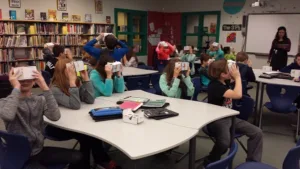Throughout the year, I conduct presentations about “Virtual Reality in Education” at various national ed-tech conferences. Some of these are deep-dive workshops, two or three hours in length, serving up rich details and specifics for information-hungry educators. Sometimes these presentations involve nimble, one-hour or less introductory talks.

No matter what type of session I offer, no matter where it is in the U.S. or abroad, I am always confronted with the same concern and asked the unavoidable question by the participants in attendance. The concern is: “Most VR seems to be an individual experience, but I want my entire class to enjoy this, with me [the teacher] included.” The question is: “Can you point me to any available VR content that allows me to take my entire class into a virtual world, I mean, all of us together?”
In most schools, teachers lament that students only have solo experiences with VR, like this group of middle schoolers. Teachers would prefer to use shared VR environments.
What these teachers are really asking for is social virtual reality. That’s what High Fidelity VR, a company that creates an open source/cross-platform development tool for VR, specializes in. The High Fidelity development environment allows educators to securely host their own shared virtual classroom environment, create shared 3D virtual reality content, or buy 3D VR content from other educators in an internal marketplace.
Now, I first met the High Fidelity folks while attending a past ISTE ed-tech conference, taking time to shrink myself (virtually) and join a “fantastic voyage”-like 3D lecture inside the human body. At that conference expo, High Fidelity was demonstrating their hosted Cell Science 3D virtual simulation (content produced by Dynamoidapps). This simulation allowed a class of students and their teachers to shrink themselves and enter a virtual world; to catch a ride on proteins, to explore molecular processes, or to walk inside a ribosome or hexokinase and map its characteristics. The High Fidelity platform also enabled the teachers and the students to communicate to each other within the virtual environment. Teachers might use those communications features to conduct tours, give assignments, provide explanations, or otherwise ask questions and assess student learning. These are the advantages that teachers are asking for when they repeatedly ask for more shared (social) virtual reality content resources.
According to High Fidelity, their development solution allows designers to create shared virtual reality experiences that support as many as 100 simultaneous avatars in the same virtual space. Some examples of educationally rich social VR environments in their marketplace include this animated exposure to the rich culture of Mexico and this National Parks tour.
When conference attendees ask me for social VR recommendations, I point them to High Fidelity, but I realize only the rarest of educators will take the time to develop their own shared VR environments. An educator’s life is just too busy. Yet I know content providers operating at the confluence point of education and social VR must exist somewhere. So, for that reason, I am making the following VR casting call: I am asking our readers to specify in our DD comments section below any companies that you know work at the intersection of education and social VR. I would like to give my session attendees more options. Thanks in advance. –Len Scrogan

